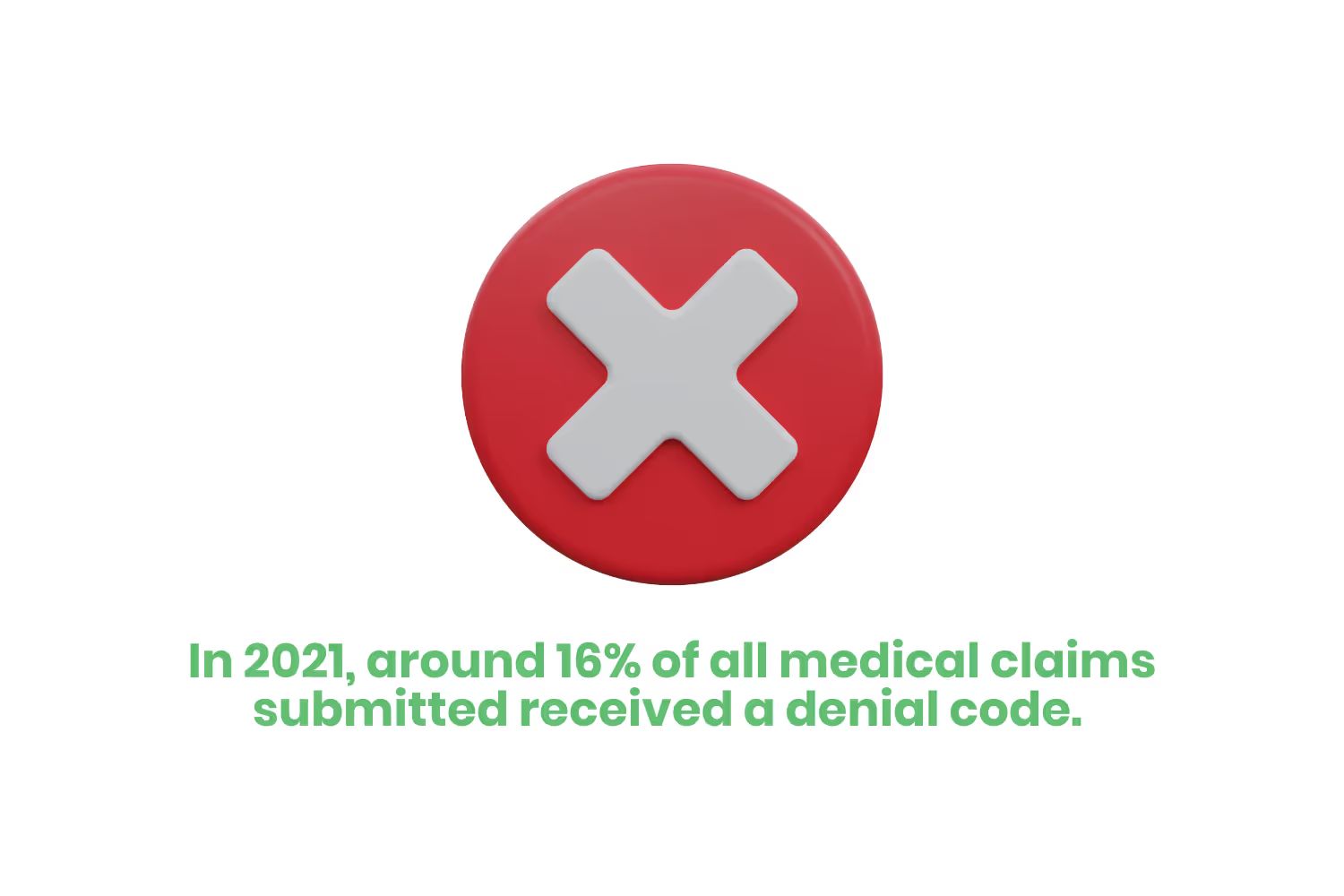What is a Revenue Code in Medical Billing
Different kinds of universal codes that apply to all insurance carriers in the United States, but including all of them here would turn this into a book. For today, let’s look at revenue codes and how important they are in the medical billing field.

In 2021, around 16% of all medical claims submitted received a denial code. That percentage may not sound like a large sum to many, but let’s look at it from a different perspective. That percentage ended up equaling about 48 million denied claims!
This goes without saying that millions of dollars sat with those denied claims, and some practices missed out on that revenue.
But how do you avoid a situation like that happening to you and your practice? Understanding the healthcare billing process and the specific standards that are in place is a great place to start. With ever-changing rules and guidelines, the idea of staying above everything is a tall order to fill. That is why many companies invest in having these responsibilities outsourced to specialists, but we will get to that later.

Here is the bottom line, you don’t need a specialist to better your productivity as a medical biller… you just need to know the basics and how to apply them on a day-to-day basis. So we are here to help you with this blog!
When it comes to medical coding, one of the most important things to understand is… well, the different codes. Different kinds of universal codes that apply to all insurance carriers in the United States, but including all of them here would turn this into a book. For today, let’s look at revenue codes and how important they are in the medical billing field.
In 2021, around 16% of all medical claims submitted received a denial code. That percentage may not sound like a large sum to many, but let’s look at it from a different perspective. That percentage ended up equaling about 48 million denied claims!
This goes without saying that millions of dollars sat with those denied claims, and some practices missed out on that revenue.
But how do you avoid a situation like that happening to you and your practice? Understanding the healthcare billing process and the specific standards that are in place is a great place to start. With ever-changing rules and guidelines, the idea of staying above everything is a tall order to fill. That is why many companies invest in having these responsibilities outsourced to specialists, but we will get to that later.

Here is the bottom line, you don’t need a specialist to better your productivity as a medical biller… you just need to know the basics and how to apply them on a day-to-day basis. So we are here to help you with this blog!
When it comes to medical coding, one of the most important things to understand is… well, the different codes. Different kinds of universal codes that apply to all insurance carriers in the United States, but including all of them here would turn this into a book. For today, let’s look at revenue codes and how important they are in the medical billing field.
First developed for the Medicare system, revenue codes were soon adopted as a standard for hospital billing as well as in other healthcare settings. Revenue codes are a standardized system that identifies any accommodations and specific services provided to patients in a healthcare setting. These services may include room and board, imaging services, medications, and more.
These codes not only tell the insurance company what kind of service the patient receives but as well as where in the hospital they received it.
The way these codes are set up is relatively simple, but there are hundreds of them. Revenue codes include three or four digits that hold information concerning a patient’s medical care and other services. These codes need to match with procedure codes for insurers to accept the claim. Note that when looking for revenue codes, they are by field 42-49 (FL 42-49) on the UB-04 (bill form used by Hospitals and other providers).
Without revenue codes, you will be hard-pressed to get an insurance company to accept your submitted claim. Therefore, you won’t be getting paid for those services.
The National Uniform Billing Committee (NUBC) maintains these revenue codes, founded in 1975 by the American Hospital Association. On top of this responsibility, the organization serves as the authority over other forms and codes used in American medical claims.
Examples of other universal codes that healthcare facilities use are:
- ICD-10 for diagnosis.
- CPT for procedures.
- HCPCS for medical supplies and services.
Revenue codes are more often than not coupled with CPT and HCPCS codes to help further explain the procedures, supplies, and treatment that a patient receives.
Purpose of Revenue Codes
What is the purpose of revenue codes? We use them to group similar types of charges onto one line in the UB-04 (aka CMS-1450) form. Insurance companies need the correct revenue codes in the form to pay the provider for their medical claim.
I touched on this earlier, but revenue codes also are important to distinguish exactly where a procedure takes place, the kind of equipment used and if the patient takes the equipment home for use. What I mean to say is that the difference between receiving treatment in the emergency room, operating room, or another department will all result in different costs! In these cases, the procedure code (CPT/HCPCS) stays the same but the revenue code varies.
Here is an example to better understand this complex subject. A medical professional can perform a blood transfusion in the emergency room or a treatment room. If the patient receives the transfusion in the emergency room, then the revenue code used is 0450. If performed in a treatment room, the code is 0761.
Another example is using a revenue code along with CPT code 12001. This CPT code stands for the “simple repair of superficial wounds of scalp, neck, axillae, external genitalia, trunk and/or extremities”. A medical professional can perform this procedure in one of three places: the emergency room, a treatment room, and an operating room. If a doctor provides procedure CPT-12001 in an operating room along with any other procedure, then the correct revenue code is 0360.
If CPT-12001 takes place in the emergency room then the revenue code is 450 and for the treatment room, the code is 761.
Due to the many different variables in a hospital setting, revenue codes have a huge role to play when it comes to having medical claims accepted by payers and receiving the proper reimbursement. So let’s get into even further detail (exciting, I know) and talk more about the numbers that make up these important codes. Plus I’ll even throw in some examples on how to read them.
Revenue Code Examples
Revenue codes at the beginning were only 3 digits long. But now with the addition of new codes, they require 4 digits. Today the code almost always has 4 digits, with the first digit being a zero. Insurance agencies now know to assume a zero for the first digit of each code.
However, when the last digit of a revenue code is zero, this means that the service is not specified as more of a “general” service. When the last digit of a code is a 9, then this indicates services categorized under “other”. These “other” services belong under the specified category but do not have a specific code.
These are only a few examples of differences between revenue codes, but the list of the codes themselves is quite extensive. There are over a hundred different categories of revenue codes. To get an idea of what I am talking about, here are some examples of popular codes.
Intensive Care Unit
Revenue codes describing specifics for intensive care categorize under the Intensive Care Unit code or 20x.
Here are further sub-categories that apply depending on procedures, the treatment, and services provided:
- General - 200
- Surgical - 201
- Medical - 202
- Pediatric - 203
- Psychiatric - 204
- Intermediate ICU - 206
- Burn Care - 207
- Trauma - 208
- Other - 209
Pharmacy
Revenue codes describing specifics for pharmaceutical treatment categorize under the Pharmacy code or 25x.
Here are further sub-categories that apply depending on treatment/medicine provided:
- General - 250
- Generic Drugs - 251
- Non-generic Drugs - 252
- Take Home Drugs - 253
- Drugs incidental to other Diagnostic Services - 254
- Drugs incidental to Radiology - 255
- Experimental Drugs - 256
- Non-prescription - 257
- IV Solutions - 258
- Other Pharmacy - 259
Physical Therapy
Revenue codes describing specifics for physical therapy services categorize under the Physical Therapy code or 42x.
Here are further sub-categories that apply depending on the type of treatment and/or service provided:
- General - 420
- Visit Charge - 421
- Hourly Charge - 422
- Group Rate - 423
- Evaluation or Reevaluation - 424
- Other Physical Therapy - 429
Emergency Room
Revenue codes describing specifics for emergency room visits categorize under the Emergency Room code or 45x.
Here are further sub-categories that apply depending on location and/or service provided:
- General - 450
- EMTALA Emergency Medical Screening Services - 451
- ER Beyond EMTALA Screening - 452
- Urgent Care - 456
- Other Emergency Room - 459
Clinic
Revenue codes describing specifics for clinic visits categorize under the Clinic code or 51x.
Here are further sub-categories that apply depending on location and/or services provided:
- General - 510
- Chronic Pain Center - 511
- Dental Clinic - 512
- Psychiatric - 513
- OB-GYN - 514
- Pediatric - 515
- Urgent Care Clinic - 516
- Family Practice Clinic - 517
- Other Clinic - 519
Medical Coding and Your Revenue Cycle
When it comes to providing the best medical coding services and being able to collect your claims, revenue codes are nothing to scoff at. They are often the main culprits when it comes to denied claims and confusion between medical billers and their insurance payers. Not only that, but revenue codes are an essential process that makes sure providers receive the best possible reimbursement and are seeing revenue growth after each clinical visit.
Using the appropriate universal codes that match a patient’s diagnosis and course of treatment, is a top priority when it comes to precise clinical coding and having your claim avoid a denial code. Thoroughly examining the procedures, organization, and systems of your coding team will help you address any underlying coding issues. Surprisingly, upper management often overlooks this when it comes to decreasing the rate of denial codes and collecting payments faster.
Today, it is standard practice to outsource revenue cycle management operations, such as coding quality assurance systems. Especially since finding qualified and experienced coders is more challenging than ever. Utilizing these procedures takes the headache away from your team by ensuring medical claims get filled out correctly before submission.
Conclusion
Revenue codes are a crucial aspect of any medical coder’s day-to-day functions. They are here to make the complex process of medical coding and billing easier. Every coding team should receive proper education and training on these codes as well as make sure to keep detailed documentation on current procedures.
Making sure your coding is accurate helps your facility receive the right amount of reimbursement for services rendered. This plays a huge role in streamlining your revenue cycle and prevents claim denials.
That is why companies are moving their revenue cycle management responsibilities to third-party organizations that specialize in the subject of universal codes and reducing your denial code rate. A coding team that frees up their time from tedious administrative work is sure to improve the quality of the company’s entire revenue cycle.
Emphasize your product's unique features or benefits to differentiate it from competitors
In nec dictum adipiscing pharetra enim etiam scelerisque dolor purus ipsum egestas cursus vulputate arcu egestas ut eu sed mollis consectetur mattis pharetra curabitur et maecenas in mattis fames consectetur ipsum quis risus mauris aliquam ornare nisl purus at ipsum nulla accumsan consectetur vestibulum suspendisse aliquam condimentum scelerisque lacinia pellentesque vestibulum condimentum turpis ligula pharetra dictum sapien facilisis sapien at sagittis et cursus congue.
- Pharetra curabitur et maecenas in mattis fames consectetur ipsum quis risus.
- Justo urna nisi auctor consequat consectetur dolor lectus blandit.
- Eget egestas volutpat lacinia vestibulum vitae mattis hendrerit.
- Ornare elit odio tellus orci bibendum dictum id sem congue enim amet diam.
Incorporate statistics or specific numbers to highlight the effectiveness or popularity of your offering
Convallis pellentesque ullamcorper sapien sed tristique fermentum proin amet quam tincidunt feugiat vitae neque quisque odio ut pellentesque ac mauris eget lectus. Pretium arcu turpis lacus sapien sit at eu sapien duis magna nunc nibh nam non ut nibh ultrices ultrices elementum egestas enim nisl sed cursus pellentesque sit dignissim enim euismod sit et convallis sed pelis viverra quam at nisl sit pharetra enim nisl nec vestibulum posuere in volutpat sed blandit neque risus.

Use time-sensitive language to encourage immediate action, such as "Limited Time Offer
Feugiat vitae neque quisque odio ut pellentesque ac mauris eget lectus. Pretium arcu turpis lacus sapien sit at eu sapien duis magna nunc nibh nam non ut nibh ultrices ultrices elementum egestas enim nisl sed cursus pellentesque sit dignissim enim euismod sit et convallis sed pelis viverra quam at nisl sit pharetra enim nisl nec vestibulum posuere in volutpat sed blandit neque risus.
- Pharetra curabitur et maecenas in mattis fames consectetur ipsum quis risus.
- Justo urna nisi auctor consequat consectetur dolor lectus blandit.
- Eget egestas volutpat lacinia vestibulum vitae mattis hendrerit.
- Ornare elit odio tellus orci bibendum dictum id sem congue enim amet diam.
Address customer pain points directly by showing how your product solves their problems
Feugiat vitae neque quisque odio ut pellentesque ac mauris eget lectus. Pretium arcu turpis lacus sapien sit at eu sapien duis magna nunc nibh nam non ut nibh ultrices ultrices elementum egestas enim nisl sed cursus pellentesque sit dignissim enim euismod sit et convallis sed pelis viverra quam at nisl sit pharetra enim nisl nec vestibulum posuere in volutpat sed blandit neque risus.
Vel etiam vel amet aenean eget in habitasse nunc duis tellus sem turpis risus aliquam ac volutpat tellus eu faucibus ullamcorper.
Tailor titles to your ideal customer segment using phrases like "Designed for Busy Professionals
Sed pretium id nibh id sit felis vitae volutpat volutpat adipiscing at sodales neque lectus mi phasellus commodo at elit suspendisse ornare faucibus lectus purus viverra in nec aliquet commodo et sed sed nisi tempor mi pellentesque arcu viverra pretium duis enim vulputate dignissim etiam ultrices vitae neque urna proin nibh diam turpis augue lacus.



![[ANSWERED] What is a Long-Term Care (LTC) Pharmacy](https://cdn.prod.website-files.com/67e2b8210878abcba6f91ae6/68d687806a075a1cf64659b0_WhatisLongTermCarePharmacy_925.avif)
